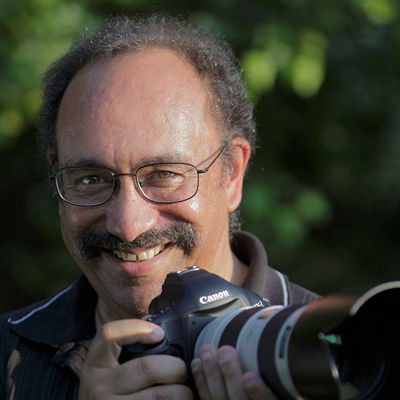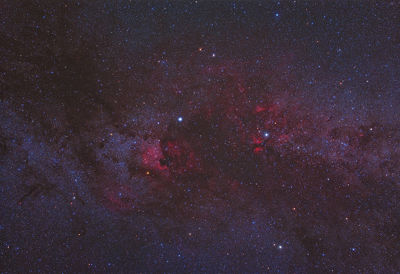A totally new ring appears on Canon RF lenses. It’s the Control Ring, and it places a new element of immediate exposure control literally into the photographer’s left hand. We’ll take a detailed look at the Control Ring in this article, and talk about how it may be applied by different types of shooters.
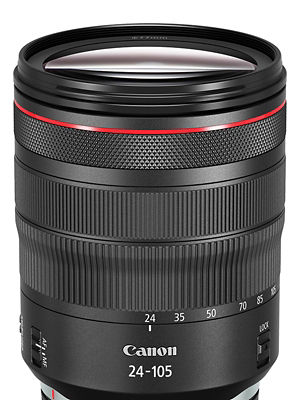
Before we go any further, this same Control Ring is also at the base of the Canon Control Ring Lens Mount Adapter EF-EOS R — meaning that if a user attaches a compatible EF or EF-S lens to the EOS R camera via this adapter, they add Control Ring functionality to the EF/EF-S lens they’re working with. Just turn the adapter’s Control Ring.
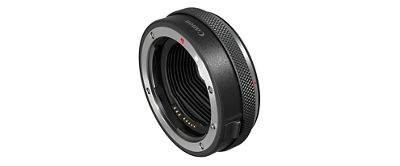
You’re entitled to ask, “Why add the Control Ring to the dedicated RF lenses?” An important reason is the change in control layout on the compact EOS R camera, vs. larger DSLRs. Most previous and current Canon EOS DSLRs, like the Canon EOS 5D or 7D series, adjust the majority of their settings during shooting by pressing a button, and turning a dial…especially when a photographer is taking still images and viewing through the eye-level viewfinder.
But with the smaller EOS R, many of those buttons no longer adorn the rear or top of the camera body. ISO control is just one example. While several methods exist to quickly adjust ISO on the EOS R camera, the Control Ring adds incredibly quick and intuitive potential for on-the-fly adjustments.
How it Operates
The Control Ring is a diamond-textured, clicked-stop ring that rotates either clockwise or counter-clockwise. It rotates continuously, unlike (for example) a zoom ring, so don’t expect it to come to a hard stop after a certain amount of rotation.
It doesn’t replace any ring currently on a Canon lens — rather, it joins the manual focus ring and (for zoom lenses) the zoom ring, giving another control element that users can adjust as they see fit, with the camera in their hands, at eye level.
You’ll feel soft click-stops as you rotate the ring in either direction. The number of clicks in a 360° rotation varies, depending upon the lens. The primary reason for the clicks is to give tactile feedback to the photographer’s fingers as he or she rotates the ring, to give a sense of how far they’re turning it.
Video users may justifiably be concerned that these slightly audible clicks may be picked up as ambient sound during recording. If this is a problem, Canon RF lenses can be modified by Canon’s service department, and have the clicks physically removed, for a service fee.
By default, you can rotate the ring in either direction, but at first there’s no impact on exposure. The reason is that the Control Ring is disabled at the camera’s factory standard settings, as it comes out of the box. To use it, you must first Enable it, and select a function for it to change, in the EOS R camera’s Custom Functions menu (Custom Functions > 4th Menu screen > Customize Dials).
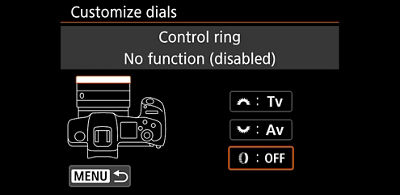
The Exposure Options
Once you press SET within “Customize Dials” in the EOS R camera’s menu, you’ll see the following choices for Control Ring adjustment — each listed twice, once with and once without a downward-facing arrow icon.
- Shutter speed
- Lens aperture
- ISO
- Exposure compensation
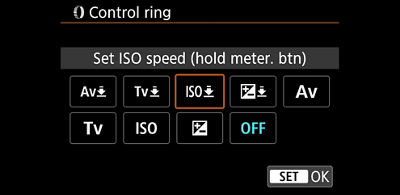
Two Fundamental Ways to Work the Control Ring
This is why the menu options come with and without the downward-facing arrow. The EOS R gives you two options in how you operate the control ring, once you’ve decided what you want it to adjust:
- [Downward arrow icon]: Adjustment only occurs if you press the shutter button halfway down, as you rotate the Control Ring.
- [No arrow icon]: Immediate exposure adjustment, any time Control Ring is turned while camera is awake
So the options with the arrow provide a bit of a safety lock, so to speak. Actual changes in exposure only happen when you’re pressing the shutter button halfway down as you turn the Control Ring.
Using the Control Ring
We obviously can’t assume to know and write every possible way a user might elect to work with the Control Ring, but here are a few possibilities to get your thought process working.
First off, the most obvious suggestion: consider using it for something you want or need frequent access to, especially if the need for changes comes up during shooting. A video user, for instance, might want to be able to quickly access his or her ISO setting, when recording with the camera in Manual exposure mode.
A few other considerations:
Exposure mode you’re working in A photographer or videographer using Manual exposure might prefer immediate access to the most important exposure elements (that is, shutter speed or aperture, or possibly ISO). On the other hand, a no-brainer for anyone using autoexposure modes might be to put Exposure Compensation at the dial.
The lighting you’re working in Especially if lighting is constantly changing, grabbing a handful of ISO with the Control Ring can make a huge difference in your imagery as scenes or lighting varies. Or, if you rely on Auto ISO to take care of those adjustments, consider using it for quick changes to another element of the exposure triangle — shutter speed or lens aperture.
E-TTL flash shooting Remember, the EOS R is fully compatible with Canon’s EX-series Speedlites, and E-TTL II flash. While flash exposure compensation unfortunately cannot be set at the Control Dial (the “Exposure Compensation” icon refers to ambient exposure adjustments only), a flash user managing available light with the camera in Manual mode could certainly speed up the process of working with different ambient light levels by assigning shutter speed to the Control Dial. Or, that same shooter working with E-TTL flash in Av mode could quickly make similar adjustments with the aforementioned Exposure Compensation applied to the Control Ring.

Summary
Seamlessly and quickly making creative inputs is a huge part of any photographer’s interaction with his or her cameras and lenses. Many prospective EOS R customers will be current EOS users, who are familiar with their DSLRs, and so some tactile motions and “muscle memory” from their previous shooting will be different with the EOS R in their hands.
The Control Ring, while a new introduction with the Canon EOS R system and its RF lenses, is a potentially important tool for photographers to have an easily-adapted method to change an exposure setting of their choice. And, this can be the case whether they’re working with Canon RF lenses, or using any compatible Canon EF or EF-S lens, via the optional Control Ring Lens Mount Adapter EF-EOS R.
The CDLC contributors are compensated spokespersons and actual users of the Canon products that they promote.




